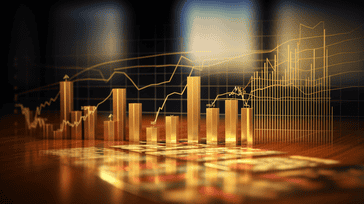Retail Investor's Guide to Interpreting Economic Indicators

As a retail investor in the US market, it can be overwhelming to keep track of the many economic indicators that are released on a regular basis. However, understanding and interpreting these indicators is crucial in making informed investment decisions. Economic indicators are key statistics that provide insights into the health of the economy, such as employment levels, inflation, and consumer spending.
By monitoring economic indicators, investors can gain a better understanding of current and future economic trends and use this information to guide their investment decisions. In this article, we will explore some of the most important economic indicators for retail investors to track in the US market.
Key Takeaways:
- Economic indicators are crucial for making informed investment decisions in the US market.
- Monitoring economic indicators can provide insights into current and future economic trends.
- Investors can use economic indicators to guide their investment decisions.
Understanding GDP Growth Rate
Gross Domestic Product (GDP) growth rate is a critical indicator used to measure the pace of a country's economic growth over a particular period. The GDP is the total value of goods and services produced within a country's borders, and the GDP growth rate is the percentage change in the GDP from one period to another.
The GDP growth rate is a vital economic indicator as it reflects the overall economic growth of a country and provides insights into the health of various sectors of the economy. For retail investors, monitoring the GDP growth rate can be crucial in making informed investment decisions. A growing economy is generally perceived as favorable for investments, while a declining economy may indicate a time to be cautious.
Moreover, the GDP growth rate can provide insights into the performance of different sectors of the economy. For instance, a higher GDP growth rate may indicate better performance in sectors such as manufacturing, retail, and services, while a lower rate could indicate a decline in these sectors.
GDP Growth Rate Formula
The formula for calculating GDP growth rate is simple. The GDP growth rate is the percentage change in GDP from one period to another. The formula for calculating GDP growth rate is:
GDP growth rate = ((GDP2 – GDP1) / GDP1) x 100
Where GDP1 is the GDP in the first period, and GDP2 is the GDP in the second period.
GDP Growth Rate and Economic Growth
The GDP growth rate is often seen as a proxy for economic growth. A growing GDP is a sign that the economy is expanding, while a declining GDP is an indication that the economy is contracting. The GDP growth rate can also provide insights into the overall health of the economy, such as inflation, unemployment rate, and interest rates.
Conclusion
The GDP growth rate is a crucial economic indicator that reflects the overall economic growth of a country. Retail investors can consider monitoring the GDP growth rate to gain insights into the health of various sectors of the economy and make informed investment decisions. However, it is essential to note that the GDP growth rate is just one of the many indicators needed to provide a comprehensive picture of the economy.
Analyzing Unemployment Rate

The unemployment rate is a critical economic indicator that reflects the overall state of the job market and labor market. It is calculated by dividing the number of unemployed individuals by the total labor force and expressed as a percentage.
The unemployment rate can have a significant impact on the economy and investment decisions. A high unemployment rate can signify an economic slowdown, as businesses may be cutting jobs to reduce costs. This, in turn, could affect consumer confidence and spending, further hindering economic growth.
Conversely, a low unemployment rate can indicate a robust job market, higher consumer confidence, and increased spending, leading to economic growth and expansion.
The Importance of Job Market Data
To gain a comprehensive understanding of the unemployment rate, investors need to monitor job market data, such as jobless claims, layoffs, and hiring data. This data can help investors gauge trends and make informed investment decisions.
For example, if jobless claims are rising, it may signal a weakening labor market and reduced consumer spending, which could negatively impact specific sectors such as retail and consumer goods.
The Relationship between Unemployment Rate and Interest Rates
The Federal Reserve considers the unemployment rate when making monetary policy decisions, such as raising or lowering interest rates. When the unemployment rate is low, the Fed may increase interest rates to keep inflation in check. Conversely, when the unemployment rate is high, the Fed may lower interest rates to stimulate economic growth and reduce unemployment.
Conclusion
Monitoring the unemployment rate and job market data is crucial for retail investors seeking to make informed investment decisions. A clear understanding of these economic indicators can help investors identify trends and opportunities in various sectors of the economy and navigate through market volatility.
Keeping Track of Inflation Rate
Inflation rate is a key economic indicator that measures the rate at which prices for goods and services increase over time. A consistently high inflation rate can erode the purchasing power of consumers, while a low inflation rate can promote economic stability and growth.
For retail investors, understanding the inflation rate is crucial to making informed investment decisions, as it can impact both consumer prices and interest rates. When the inflation rate is high, central banks may raise interest rates to curb inflation, which can increase the cost of borrowing and reduce consumer spending.
On the other hand, a low inflation rate can stimulate borrowing and spending, which can drive economic growth and boost investments in certain sectors. Retail investors should monitor inflation rates to determine how it affects consumer prices and purchasing power, as well as overall economic activity.
Impact of Inflation on Purchasing Power
Inflation can significantly impact purchasing power, which is the amount of goods and services that can be bought with a specific amount of currency. When prices rise due to inflation, the purchasing power of a currency decreases, which means that it takes more money to buy the same amount of goods or services.
For example, if the inflation rate is 3% and the cost of a gallon of milk is $3, after a year, the price of milk would rise to $3.09 due to inflation. This means that the purchasing power of $3 is now only $2.91, which can affect consumer behavior and spending patterns.
Impact of Inflation on Consumer Prices
Inflation can impact consumer prices in various ways, depending on the goods and services being consumed. Some items, such as food and gasoline, are more sensitive to inflation and may experience more significant price increases over time.
Retail investors should consider how inflation impacts the industries they are investing in and the potential impact on consumer prices. For example, if a company produces a consumer product that is sensitive to inflation, such as food or clothing, then a high inflation rate could lead to decreased sales and revenue. On the other hand, if the company produces a product that is less sensitive to inflation, such as technology, then the impact of inflation may be minimal.
Conclusion
Understanding inflation rate and its impact on the economy and consumer behavior is crucial for retail investors. By monitoring inflation rates, investors can gain insights into the potential impact on interest rates, consumer prices, and overall economic activity. This knowledge can help investors make informed decisions about their investments and navigate inflationary environments.
Assessing Consumer Confidence Index

One important economic indicator that retail investors should pay attention to is the consumer confidence index. This index measures the level of confidence that consumers have in the overall state of the economy and their personal financial situation.
Understanding consumer sentiment is essential for retail investors as it can provide insights into spending patterns. When consumers are confident about the economy, they are more likely to spend money, which can boost business performance and the stock market.
"Consumer spending accounts for about two-thirds of US economic activity, so it's crucial to have a good grasp of consumer confidence and spending patterns."
The consumer confidence index is based on a monthly survey of US households conducted by the Conference Board. The survey asks participants about their views on the current state of the economy, their job prospects, and their spending plans.
The consumer confidence index is reported as two separate measures: the present situation index, which reflects consumers' current assessment of the economy, and the expectations index, which measures their outlook for the coming months.
When the consumer confidence index is high, it suggests that consumers are optimistic about the economy and their personal financial situation. This can lead to increased spending and investment, which can have a positive impact on the stock market and other sectors of the economy.
How to Interpret Consumer Confidence Index Data
The consumer confidence index is reported as a numerical value, with a baseline of 100 set in 1985. A value above 100 indicates that consumers are more confident than they were in 1985, while a value below 100 indicates less confidence.
It's essential to keep in mind that the consumer confidence index is just one economic indicator and should not be used in isolation to make investment decisions. Instead, investors should consider a range of economic indicators and market data when making investment decisions.
When interpreting consumer confidence index data, retail investors should look for trends over time rather than focusing on any single data point. For example, if the consumer confidence index has been trending upwards over several months, it indicates that consumers are becoming more optimistic about the economy.
Similarly, investors should consider the relationship between the consumer confidence index and other economic indicators. For example, if the consumer confidence index is high, but the unemployment rate is also high, it may indicate that consumers are optimistic despite a weak job market.
In Summary
The consumer confidence index is a crucial economic indicator that can provide insights into consumer sentiment and spending patterns. Retail investors should pay attention to the consumer confidence index, along with other economic indicators, when making investment decisions.
Analyzing Stock Market Performance
As a retail investor, interpreting stock market performance is a crucial part of making informed investment decisions. The stock market is often used as an economic indicator, reflecting the state of the equity market and the broader economy.
One way to analyze stock market performance is by tracking stock indices, such as the S&P 500 or Nasdaq Composite. These indices track the performance of a set of stocks that represent a particular segment of the market, providing insight into how that sector is faring.
It's also important to monitor the overall trend of the stock market, whether it's on an upward or downward trajectory. Trends can signal the general mood of investors, as well as their expectations for future economic growth.
"The stock market is a device for transferring money from the impatient to the patient." - Warren Buffet
It's essential to remember that the stock market can be volatile and subject to short-term fluctuations. Therefore, it's important to analyze trends over a more extended period and not make hasty investment decisions based on short-term market movements.
Comparing Stock Market Performance
A helpful way to analyze stock market performance is by comparing it to other economic indicators. For example, if the stock market is on an upward trend while the GDP growth rate is declining, it may indicate that investors are optimistic about future growth despite the current slowdown in economic activity.
| Stock Market Performance | GDP Growth Rate | |
|---|---|---|
| 2020 Q1 | +10% | -2% |
| 2020 Q2 | -5% | -9% |
| 2020 Q3 | +7% | +4% |
The table above compares the stock market performance and GDP growth rate for three quarters in 2020. It highlights a significant contrast between the second quarter, where the stock market declined while the GDP growth rate also contracted, with the third quarter, where both indicators rebounded.
Comparing stock market performance to other indicators can offer valuable insights for retail investors when making investment decisions. It can help investors anticipate future economic trends and adjust their investment strategies accordingly.
Understanding Interest Rates

Interest rates play a critical role in the economy and affect a wide range of financial decisions, including borrowing costs, savings rates, and investment returns. As a retail investor, it's essential to understand how interest rates work and their impact on your investment decisions.
What are Interest Rates?
Interest rates represent the cost of borrowing money, typically expressed as a percentage of the loan amount. They are set by the Federal Reserve, the central bank in the US, as part of its monetary policy to manage the economy.
How do Interest Rates Affect Borrowing Costs and Savings Rates?
When interest rates are low, borrowing becomes more affordable, encouraging consumers and businesses to take on more debt. Conversely, when interest rates are high, borrowing becomes more expensive, and consumers and businesses are more likely to cut back on spending and investing.
Low-interest rates also mean lower savings rates for savers. Banks and other financial institutions pay less interest on savings accounts and other deposit products when interest rates are low.
How do Interest Rates Affect Investment Returns?
Interest rates can also impact the performance of various asset classes. When interest rates are low, stocks and other riskier assets tend to perform better because investors are looking for higher returns. Conversely, when interest rates are high, bonds and other fixed-income investments become more attractive because they provide a higher yield.
In general, retail investors should keep an eye on interest rates and how they impact their investments. For example, if you're considering taking out a mortgage, it may be worthwhile to wait for lower interest rates. On the other hand, if you're looking to invest in bonds, it may be better to wait for higher interest rates to maximize your returns.
Conclusion
Understanding interest rates is crucial for making informed investment decisions as a retail investor in the US market. By keeping an eye on interest rate changes and how they impact borrowing costs, savings rates, and investment returns, you can position yourself for success in any economic environment.
Monitoring Manufacturing Index
The Manufacturing Index is a crucial economic indicator that reflects industrial activity and production levels in a given country. It measures the output of the manufacturing sector, which includes goods-producing industries such as food, chemicals, automobiles, and electronics.
The Manufacturing Index is released by the Institute for Supply Management (ISM), and it is based on a survey of purchasing managers from various industries. The survey asks managers to rate different components of their business, including new orders, production levels, employment, supplier deliveries, and inventories.
The Manufacturing Index is reported as a percentage and is closely watched by investors and market analysts because it provides insights into the overall health of the economy. If the index is above 50%, it indicates that the manufacturing sector is expanding, while a reading below 50% suggests contraction.
"The Manufacturing Index is a critical indicator of economic growth and a leading indicator of future inflation."
When the Manufacturing Index is high, it can indicate strong consumer demand, increased business investment, and healthy profit margins. On the other hand, a low Manufacturing Index may suggest a drop in consumer spending or a slowdown in manufacturing production that could lead to layoffs and reduced economic growth.
Comparing Manufacturing Index and Stock Market Performance
While the stock market is often seen as a barometer of the economy, the Manufacturing Index can provide valuable insights into future stock market trends. Historically, the Manufacturing Index has had a strong correlation with the performance of the equity market.
A rising Manufacturing Index can be an indicator of increased corporate earnings and profitability within the manufacturing sector, leading to higher stock prices. In contrast, a decline in the Manufacturing Index may suggest a potential drop in corporate earnings and result in lower stock prices.
| Manufacturing Index | S&P 500 Performance |
|---|---|
| 50% | Neutral |
| Above 50% | Positive |
| Below 50% | Negative |
As shown in the table above, the Manufacturing Index can be a valuable tool for retail investors when assessing the overall health of the economy and making investment decisions based on stock market trends.
Tracking Consumer Spending and Business Investment
Consumer spending and business investment are key components of economic activity. As a retail investor, it is essential to monitor changes in both indicators to make informed investment decisions.
The amount of money consumers spend on goods and services is a critical driver of economic growth. When consumer spending increases, businesses are likely to ramp up production levels to meet demand, leading to increased economic activity. On the other hand, a decrease in consumer spending can result in reduced business activity and even a recession.
Business investment refers to capital expenditures made by companies to expand their operations. For example, a company may invest in new equipment or open a new factory to increase production levels. These investments can generate job opportunities and stimulate economic growth.
Monitoring consumer spending and business investment can provide valuable insights into the overall health of the economy. For instance, if consumer spending and business investment are both increasing, it suggests that the economy is growing. However, if both indicators are decreasing, it may indicate an economic slowdown or recession.
Here's a comparative table highlighting the trends in consumer spending and business investment in the US from 2018 to 2020:
| Year | Consumer Spending (in trillions of dollars) | Business Investment (in trillions of dollars) |
|---|---|---|
| 2018 | 14.93 | 2.44 |
| 2019 | 15.06 | 2.33 |
| 2020 | 13.62 | 2.08 |
As the table shows, consumer spending increased from 2018 to 2019 and then decreased in 2020. Business investment, on the other hand, decreased from 2018 to 2019 and then again from 2019 to 2020. These trends could indicate a slowdown or recession in the US economy.
As a retail investor, it is essential to keep an eye on changes in consumer spending and business investment to make informed investment decisions. By monitoring these two indicators, you can gain insights into the overall health of the economy and identify sectors that are likely to perform well in the future.
Conclusion
Understanding and interpreting economic indicators is crucial for making informed investment decisions in the US market. By keeping track of GDP growth rate, unemployment rate, inflation rate, consumer confidence index, stock market performance, interest rates, manufacturing index, consumer spending, and business investment, retail investors can gain insights into the overall health of the economy and make informed investment decisions.
It is important to note that economic indicators should not be analyzed in isolation, as they are interrelated and can impact each other. Therefore, it is recommended to analyze multiple indicators together to gain a comprehensive understanding of the economic landscape.
By staying up-to-date on economic indicators and their implications, retail investors can navigate the US market with greater confidence and make informed investment decisions that align with their financial goals and risk tolerance. So, take advantage of the wealth of information available and use economic indicators to your advantage!
FAQ
What are economic indicators?
Economic indicators are statistical data points that provide insights into the overall health and performance of an economy. They can include measures such as GDP growth rate, unemployment rate, inflation rate, consumer confidence index, stock market performance, interest rates, manufacturing index, and consumer spending and business investment.
Why are economic indicators important for retail investors?
Economic indicators are important for retail investors because they provide valuable information about the state of the economy and can help guide investment decisions. By monitoring and interpreting these indicators, investors can gain insights into trends, anticipate potential risks, and make more informed choices about where to allocate their investment capital.
How can GDP growth rate impact investment decisions?
GDP growth rate reflects the overall expansion or contraction of a country's economy. Positive GDP growth indicates economic prosperity, which can lead to increased business opportunities and higher investment returns. Retail investors often consider the GDP growth rate when assessing the potential profitability of investments in specific sectors or industries.
What does the unemployment rate tell us?
The unemployment rate measures the percentage of individuals who are actively seeking employment but are currently unemployed. Changes in the unemployment rate can indicate the health of the job market and influence consumer behavior and business performance. Retail investors may monitor the unemployment rate to assess the potential impact on specific sectors and gauge the overall strength of the economy.
How does inflation rate affect investments?
Inflation rate measures the rate at which consumer prices are increasing over time. High inflation can erode the purchasing power of money, impacting investment returns. Retail investors often consider the inflation rate when making investment decisions to ensure that their investments can effectively preserve and grow their wealth in real terms.
What is the consumer confidence index?
The consumer confidence index measures the sentiment and optimism of consumers regarding the overall state of the economy and their personal financial situation. It is used to assess consumer spending patterns and predict future economic trends. Retail investors may analyze the consumer confidence index to gain insights into consumer behavior and make informed investment decisions.
How can stock market performance be interpreted as an economic indicator?
The stock market performance reflects the buying and selling activities of investors in publicly traded companies. It is often considered an indicator of investor sentiment and can provide insights into the overall state of the economy. Retail investors may analyze stock market trends to identify potential investment opportunities or assess the broader economic conditions that may influence their investments.
Why is understanding interest rates important for retail investors?
Interest rates impact borrowing costs, spending patterns, and the performance of various sectors, making them a crucial factor for retail investors to consider. Changes in interest rates can influence investment decisions, as they affect the profitability of investments and the affordability of borrowing for businesses and consumers.
What does the manufacturing index indicate?
The manufacturing index provides insights into the performance and activity levels of the industrial sector. Changes in the manufacturing index can reflect shifts in production, employment, and overall economic growth. Retail investors may monitor the manufacturing index to understand broader economic trends and assess potential investment opportunities in industries related to manufacturing.
Why are consumer spending and business investment important economic indicators?
Consumer spending and business investment are key drivers of economic activity. Changes in consumer spending patterns can indicate the strength of the economy and impact various sectors. Business investment levels reflect the confidence of businesses in the future prospects of the economy. Retail investors often analyze consumer spending and business investment to gain insights into the overall health of the economy and make informed investment decisions.